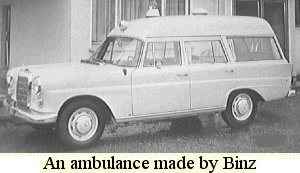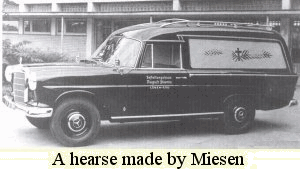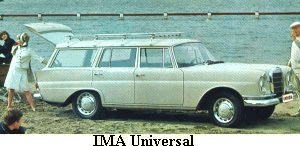
|
 |
Mercedes went very carefully ahead with the introduction of an estate or kombi Heckflosse
in the middle of the 1960s. |
 There were a couple of
specialists who build a special version during 1962. Two of the most well-known
specialists were Miesen form Bonn and Binz from Lorch, both situated in Germany. Both
coachbuilders had already build special models using its predecessor: the Ponton. These
specialists mainly build Ambulance cars and hearses, an estate version was very seldom
build for private use. The types from Miesen and Binz remained available on the 190 and
190D rolling chassis through the end of the production in 1965, when 200 and 200D editions
took over. |
 When Mercedes decided
to include an estate car in the official car program, they must have had a total
confidence that an estate version should be successful in the future. Volkswagen made a
brake-trough for estate cars in 1961 with the launch of the first middle-class estate car,
the VW 1500 Variant. Suddenly people were seeing the estate car less and less as a
delivery van but as a family car. In the end of the 1970s Mercedes included a
"home-build" estate car into their range on basis of the W123 which was a big
success. Since then, the estate version of a Mercedes has always been very popular. When Mercedes decided
to include an estate car in the official car program, they must have had a total
confidence that an estate version should be successful in the future. Volkswagen made a
brake-trough for estate cars in 1961 with the launch of the first middle-class estate car,
the VW 1500 Variant. Suddenly people were seeing the estate car less and less as a
delivery van but as a family car. In the end of the 1970s Mercedes included a
"home-build" estate car into their range on basis of the W123 which was a big
success. Since then, the estate version of a Mercedes has always been very popular.
|
 The Belgian
coachbuilder IMA was chosen for this honor. Around 2000 Universals were build by them,
around 5000 were planned though. The start was very good, in may 1966 they already had
build 1000 Universals. Production started with the 190 and the 190D in the early 1965 and
changed over to the 200, 200D, 230 and 230S in the autumn of the same year. The Belgian
coachbuilder IMA was chosen for this honor. Around 2000 Universals were build by them,
around 5000 were planned though. The start was very good, in may 1966 they already had
build 1000 Universals. Production started with the 190 and the 190D in the early 1965 and
changed over to the 200, 200D, 230 and 230S in the autumn of the same year.
The dimensions of the Universal were the same as the saloon cars, only in height did they
differ: the Universal was 3,5 cm higher. The car weighed around 105 kg more than the
saloon cars. The most important difference between the Universal from IMA and those from
Miesen and Binz was the production method.
|
 The basis for the Universal from IMA was a
stripped saloon with no roof. Not only did IMA uses original factory pressed parts but
they also used some "home-made" parts. The most important that IMA made itself
was the roof of the Universal, that is why today these cars have a very elegant look about
them. These cars could also be easily marked as "IMA-made" because of the
stylized triangular rear lights clusters. As these cars, including the ones build by
Miesen and Binz, were likely to be called upon to carry heavier loads than the saloons,
Mercedes equipped their rolling chassis with larger 15in wheels and with a self-levelling
strut as standard. The basis for the Universal from IMA was a
stripped saloon with no roof. Not only did IMA uses original factory pressed parts but
they also used some "home-made" parts. The most important that IMA made itself
was the roof of the Universal, that is why today these cars have a very elegant look about
them. These cars could also be easily marked as "IMA-made" because of the
stylized triangular rear lights clusters. As these cars, including the ones build by
Miesen and Binz, were likely to be called upon to carry heavier loads than the saloons,
Mercedes equipped their rolling chassis with larger 15in wheels and with a self-levelling
strut as standard.
|
What was special about the Universal is that it could be supplied with a split folding
rear seat so that the space could be used more practically. You could even order an
backseat that folded in two uneven parts so that one person could still make use of the
backseat while large luggage still found a place in the back of the car. For the middle of
the 1960s this was a rather rare option for an estate car but it showed that Mercedes was
thinking quite ahead. Another unusual option was a rearward-facing occasional bench seat
in the load bed which folded away when not in use.
But the success didn't last very long. By the end of 1966, IMA filed
bankruptcy. What most people don't know is that IMA also build the regular saloon
Fintails, about 25 a day in the summer of 1966.
Around 6203 under-carriages left the Mercedes factories for special body work conversions.
Most of them went through life as 200D (2253), next in line was the 190D (1825), than the
190 (724), the 230 (639), the 200 (418) and finally the 230S (341). The 220 was only used
three times for special body work conversion. It could be that in these numbers the saloon
cars build by IMA are also included.
|
